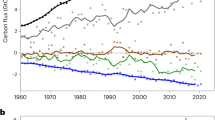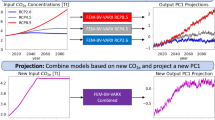Abstract
Uncertainty in the response of the global carbon cycle to anthropogenic emissions plays a key role in assessments of potential future climate change and response strategies. We investigate how fast this uncertainty might change as additional data on the global carbon budget becomes available over the twenty-first century. Using a simple global carbon cycle model and focusing on both parameter and structural uncertainty in the terrestrial sink, we find that additional global data leads to substantial learning (i.e., changes in uncertainty) under some conditions but not others. If the model structure is assumed known and only parameter uncertainty is considered, learning is rather limited if observational errors in the data or the magnitude of unexplained natural variability are not reduced. Learning about parameter values can be substantial, however, when errors in data or unexplained variability are reduced. We also find that, on the one hand, uncertainty in the model structure has a much bigger impact on uncertainty in projections of future atmospheric composition than does parameter uncertainty. But on the other, it is also possible to learn more about the model structure than the parameter values, even from global budget data that does not improve over time in terms of its associated errors. As an example, we illustrate how one standard model structure, if incorrect, could become inconsistent with global budget data within 40 years. The rate of learning in this analysis is affected by the choice of a relatively simple carbon cycle model, the use of observations only of global emissions and atmospheric concentration, and the assumption of perfect autocorrelation in observational errors and variability. Future work could usefully improve the approach in each of these areas.
Similar content being viewed by others
References
Cox PM, Betts RA, Jones CD, Spall SA, Totterdell IJ (2000) Acceleration of global warming due to carbon-cycle feedbacks in a coupled climate model. Nature 408:184–187
Cramer W et al (2001) Global response of terrestrial ecosystem structure and function to CO2 and climate change. Results from six dynamic global vegetation models. Glob Chang Biol 7:357–373
Friedlingstein P, Dufresne J-L, Cox PM, Rayner P (2003) How positive is the feedback between climate change and the carbon cycle. Tellus 55B:692–700
Friedlingstein P et al (2006) Climate–carbon cycle feedback analysis: results from the C4MIP model intercomparison. J Climate 19:3337–3353
Houghton RA, Hackler JL (2002) Carbon flux to the atmosphere from land-use changes. In: Trends: a compendium of data on global change. Carbon Dioxide Information Analysis Center, Oak Ridge National Laboratory, US Department of Energy, Oak Ridge, TN, USA
Houghton, RA (2003) Revised estimates of the annual net flux of carbon to the atmosphere from changes in land use and land management 1850–2000, Tellus, 55B, 378–390
Ito A (2005) Climate-related uncertainties in projections of the 21st century terrestrial carbon budget: Off-line model experiments using IPCC greenhouse gas scenarios and AOGCM climate projections. Clim Dyn 24:435–448
Jain AK, Yang X (2005) Modeling the effects of two different land cover change data sets on the carbon stocks of plants and soils in concert with CO2 and climate change. Glob Biogeochem Cycles 19(2):GB2015
Jain AK, Kheshgi HS, Hoffert MI, Wuebbles DJ (1995) Distribution of radiocarbon as a test of global carbon cycle models. Glob Biogeochem Cycles 9:153–166
Keeling CD, Whorf TP (2005) Atmospheric CO2 records from sites in the SIO air sampling network. In trends: a compendium of data on global change. Carbon Dioxide Information Analysis Center, Oak Ridge National Laboratory, U.S. Department of Energy, Oak Ridge, TN, USA
Keller K, McInerny D (2008) The dynamics of learning about a climate threshold. Clim Dyn 30:321–332
Kheshgi HS, Jain AK (2003) Projecting future climate change: implications of carbon cycle model intercomparisons. Glob Biogeochem Cycles 17(2):1047
Kheshgi HS, Jain AK, Wuebbles DJ (1996) Accounting for the missing carbon sink with the CO2 fertilization effect. Clim Change 33:31–62
Kheshgi HS, Jain AK, Wuebbles DJ (1999) Model-based estimation of the global carbon budget and its uncertainty from carbon dioxide and carbon isotope records. J Geophys Res 104(D24):31, 127–131, 143
Marland G, Boden TA, Andres RJ (2006) Global, regional, and national CO2 emissions. In: Trends: a compendium of data on global change. Carbon Dioxide Information Analysis Center, Oak Ridge National Laboratory, U.S. Department of Energy, Oak Ridge, TN, USA
Meehl GA, Stocker TF, Collins WD, Friedlingstein P, Gaye AT, Gregory JM, Kitoh A, Knutti R, Murphy JM, Noda A, Raper SCB, Watterson IG, Weaver AJ, Zhao Z-C (2007) Global climate projections. In: Solomon S, Qin D et al (eds) Climate change 2007: the physical science basis. Contribution of Working Group I to the Fourth Assessment Report of the Intergovernmental Panel on Climate Change. Cambridge University Press, Cambridge, UK, USA
Melnikov NB, O’Neill BC (2006) Learning about the carbon cycle from global budget data. Geophys Res Lett 33:L02705
Nakicenovic N et al (2000) IPCC Special Report on Emissions Scenarios. Cambridge University Press, New York. http://sres.ciesin.org/final_data.html
O’Neill BC (2008) Learning and climate change. Clim Change (this issue)
Oppenheimer M, O’Neill BC, Webster M (2008) Negative learning. Clim Change DOI 10.1007/s10584-008-9405-1
Prentice I, Farquhar GD et al (2001) The carbon cycle and atmospheric carbon dioxide. In: Houghton JT (ed) Climate change 2001: the scientific basis. Cambridge University Press, Cambridge, pp 183–237
Ramankutty N, Foley JA (1999) Estimating historical changes in global land cover: croplands from 1700 to 1992. Glob Biogeochem Cycles 13(4):997–1027
Riahi K, Grubler A et al (2006) Scenarios of long-term socio-economic and environmental development under climate stabilization. Technol Forecast Soc Change 74:887–935
Webster M, Jakobovits L, Norton J (2008) Learning about climate change and implications for near-term policy. Clim Change DOI 10.1007/s10584-008-9406-0
Wigley TML (2000) Stabilization of CO2 concentration levels. In: Wigley TML, Schimel DS (eds) The carbon cycle. Cambridge University Press, New York, pp 258–276
References for the Appendix
Houghton RA, Hackler JL (1999) Emissions of carbon from forestry and land-use change in tropical Asia. Glob Chang Biol 5:481–492
Houghton RA, Hackler JL (2002) Carbon flux to the atmosphere from land-use changes. In: Trends: a compendium of data on global change. Carbon Dioxide Information Analysis Center, Oak Ridge National Laboratory, U.S. Department of Energy, Oak Ridge, TN, USA
Jain AK, Yang X (2005) Modeling the effects of two different land cover change data sets on the carbon stocks of plants and soils in concert with CO2 and climate change. Glob Biogeochem Cycles 19(2):GB2015
Ramankutty N, Foley JA (1998) Characterizing patterns of global land use: an analysis of global croplands data. Glob Biogeochem Cycles 12:667–685
Ramankutty N, Foley JA (1999) Estimating historical changes in global land cover: croplands from 1700 to 1992. Glob Biogeochem Cycles 13(4):997–1027
Tikhonov AN, Arsenin VY (1977) Solutions of ill-posed problems. Winston and Sons, Washington, p 258
Author information
Authors and Affiliations
Corresponding author
Rights and permissions
About this article
Cite this article
O’Neill, B.C., Melnikov, N.B. Learning about parameter and structural uncertainty in carbon cycle models. Climatic Change 89, 23–44 (2008). https://doi.org/10.1007/s10584-008-9404-2
Received:
Accepted:
Published:
Issue Date:
DOI: https://doi.org/10.1007/s10584-008-9404-2




